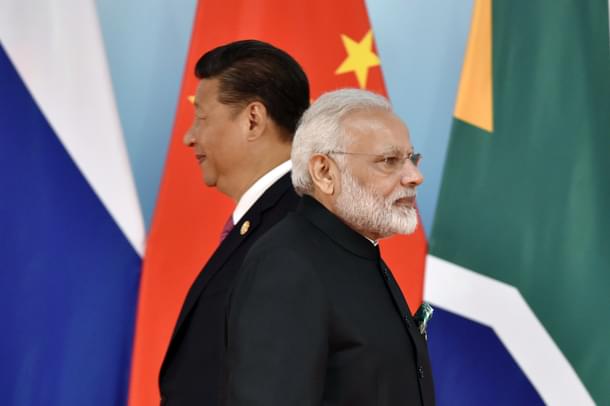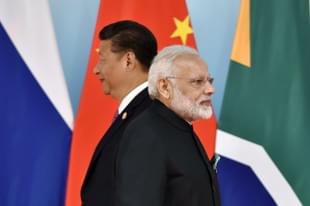Politics
Kashmir And More: India Must Learn From How China Uses Market Size To Make Big Businesses Respect Its Interests
Tushar Gupta
Sep 30, 2019, 03:05 PM | Updated 03:05 PM IST
Save & read from anywhere!
Bookmark stories for easy access on any device or the Swarajya app.


Earlier this year in June, US athletic apparel and footwear giant Nike had to withdraw some of its sneaker offerings from China. The sneakers had been designed by Nike in collaboration with a Japanese streetwear fashion label, ‘Undercover’, headed by designer Jun Takahashi.
In the same month, Undercover had showcased its support for the pro-democracy protesters in Hong Kong through an Instagram story stating ‘No Extradition to China’ and ‘Go Hong Kong’, and, therefore, the withdrawal was necessary.
Clearly, Nike was willing to appease one of its most critical markets. Also, 26 per cent of Nike’s footwear and apparel were produced in China in 2018, and, therefore, the brand was not willing to risk cheap labour and a thriving market.
Nike is not alone, however.
Last year, the fashion label ‘Gap’ apologised for one of their T-shirts that had a China map but without Taiwan as its part. Gap apologised and agreed to withdraw the T-shirt from the Chinese market.
Gap was not alone in this fiasco. Those who have apologised for upsetting the Chinese Communist Party include Air Canada, US’ Delta Airlines, and Marriott. In Marriott’s case, the company’s websites and apps were blocked for a week until it apologised and announced that it had decided to show Taiwan as part of China.
Dolce and Gabbana, Union Bank of Switzerland, Zara, and Mercedes-Benz, among others, have also apologised for not towing the Chinese line.
Turns out, China’s backlash depends on events beyond its borders too.
In March 2017, several companies in China decided to boycott South Korea’s Lotte Group, one of South Korea’s major retail operators in China. Indirect action was taken against the company on multiple fronts.
This happened because the company had agreed to provide land to host the Terminal High-Altitude Area Defence System (THAAD) in South Korea. While the THAAD installation was a preventive measure against North Korea, China saw it as a national security threat, and thus, consequences followed.
China is critical to the operations of Cathay Pacific, Hong Kong’s iconic airline. And when its employees were seen participating alongside the pro-democracy protesters in Hong Kong, China used this leverage and forced the airline to take action.
Following the Cathay fiasco, KPMG and PwC issued directives to their employees against participating in the Hong Kong protests.
No company, be it a fashion label, a luxury automobile manufacturer, or even an airline, wants to miss out on the opportunities that lie within a $13 trillion economy. Eventually, they all sing to the tune of the Communist Party.
Now, compare this with what happens in India.
From Kashmir not being shown on the map used by companies like Google to rampant Hinduphobia on Netflix’s shows and in television advertisements of foreign-owned big business, all these continue unabated. Shoppers often complain about Amazon selling products that insult Hindu deities but no sustained action has ever been witnessed.
And as if this wasn’t enough, many countries apart from China and Pakistan have also started questioning Indian sovereignty over Kashmir.
After China and Turkey, Malaysia has asked for intervention in the Kashmir conflict at the United Nations. The country’s 94-year-old Prime Minister, Mahathir Mohamad, accused India of “invading and occupying the country” of Jammu and Kashmir.
Just days ago, the Malaysian Prime Minister had said that Muslim countries are silent about the persecution of Uyghurs "because China is a very powerful nation".
What enables China to dictate the terms when it comes to issues like Taiwan, Tibet, Hong Kong, racism, and anything that remotely constitutes as a cultural or a consumer insult is the interrelation of three factors — the size of its economy, availability of cheap labour and its market size.
The size of India’s economy is nowhere close to China’s but in the larger scheme of things, it is the seventh biggest economy in the world by virtue of GDP. The presence of cheap labour in India makes for a lucrative manufacturing prospect for the likes of Nike, Apple, and other giants who might want to leave China.
The only parameter where India comes close to China is in its market size. In terms of consumer spending, the 2020s will see the Indian middle class expanding. People, who shall swipe their first credit cards, and make their first digital transactions, will move to the cities from villages.
Thus, with 800-million active internet users by 2022, and perhaps, a billion by 2025, it lies in the greater interests of India to learn from China when it comes to getting the companies to toe its line.
The message should be simple for any company — if they wish to have access to the Indian market, respect for Indian values and interests is non-negotiable. The size of the economy must be used to nudge big businesses into compliance.
Of course, India does not necessarily need to adopt the Chinese model. But India will surely benefit from learning how China uses its market size to work in its favour.
Tushar is a senior-sub-editor at Swarajya. He tweets at @Tushar15_





